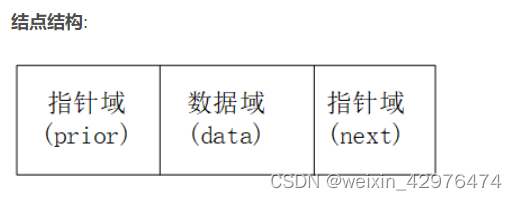前言
上一篇文章中我们学习了单链表的实现 本节将带大家学习带头双向链表的实现,希望能够对大家有一些帮助,话不多说,直接开干!!
文章目录
一、带头双向链表的概念和结构
概念:带头双向链表是一种 带不存储数据的哨兵卫,循环,双向的一种链表结构。它的每个数据结点中都有两个指针,分别指向直接后继和直接前驱。
特点:
- 在数据结构中具有双向指针
- 插入数据的时候方便找到上一个
- 同样,删除数据的是有也需要考虑前后方向的操作

和单链表的比较:
1.无头单向非循环链表:结构简单,但一般不会单独用来存数据。实际中更多是作为其他数据结构的子结构,如哈希桶,图的邻接表等等。另外,这种结构在笔试中出现很多。。
2.带头双向循环链表:结构最复杂,一般用在单独存储数据。实际中使用的链表数据结构,都是带头双向循环链表。另外,这个结构虽然结构复杂,但是使用代码实现以后会发现结构会带来很多优势,实现反而简单。后面我们代码实现了就知道了。


看代码
typedef int LTDataType;
typedef struct ListNode
{
LTDataType data;
struct ListNode* next;
struct ListNode* prev;
}ListNode;
首先我们定义了一个结构体,结构体里的data被叫做数据域用来存放数据,next是指针域用来存放下一个节点的地址,prev是指针域用来存放上一个节点的地址。
二. 带头双向链表的接口实现
我们要实现如下的一些接口:
// 创建返回链表的头结点.
ListNode* ListCreate();
// 双向链表销毁
void ListDestory(ListNode** pHead);
// 双向链表打印
void ListPrint(ListNode* pHead);
// 双向链表尾插
void ListPushBack(ListNode* pHead, LTDataType x);
// 双向链表尾删
void ListPopBack(ListNode* pHead);
// 双向链表头插
void ListPushFront(ListNode* pHead, LTDataType x);
// 双向链表头删
void ListPopFront(ListNode* pHead);
// 双向链表查找
ListNode* ListFind(ListNode* pHead, LTDataType x);
// 双向链表在pos的前面进行插入
void ListInsert(ListNode* pos, LTDataType x);
// 双向链表删除pos位置的节点
void ListErase(ListNode* pos);
2.1 打印
*注意:头指针的位置不要轻易的去改动,所以在这定义了一个Cur来代替我们的头指针。
代码示例如下
// 单链表打印
void ListPrint(ListNode* pHead)
{
assert(pHead);
ListNode* cur=pHead->next;
while(cur!=pHead) //这个条件很重要的
{
printf("%d->",cur->data);
cur=cur->next;
}
printf("NULL\n");
}
2.2 初始化
- 注意:带头双向链表的初始化 需要创建一个哨兵卫的头指针,该位置不存储有效数据 。
// 创建返回链表的头结点.
ListNode* ListCreate()
{
ListNode* phead=BuySListNode(-1);
phead->next=phead;
phead->prev=phead;
return phead;
}
2.3 开辟节点
**当我们插入的时候需要开辟新的节点,而我们有头插、尾插和任意位置插,每次写这些插入的时候都要<br />
申请节点,所以我们不妨写一个函数就直接申请节点,后面只需要调用就好了**
代码实现:
LTDataType* BuySListNode(LTDataType x)
{
LTDataType* newnode=(LTDataType*) malloc(sizeof(ListNode));
assert(newnode);
newnode->data=x;
newnode->next=NULL;
newnode->prev=NULL;
return newnode;
}
2.4 尾部插入节点
要尾插的话,我们首先得要开辟一个结点才能插啊,其次是要找到尾结点,那么如何找到尾结点呢?很简单,一个while循环就搞定了。
代码示例如下:
// 单链表尾插
void ListPushBack(ListNode* pHead, LTDataType x)
{
ListNode* newNode = BuySListNode(x);
// 先不断开原链表,然后新节点连接到链表中
newNode->prev = pHead->prev;
newNode->next = pHead;
newNode->prev->next = newNode;
pHead->prev = newNode;
}
2.5 尾部删除节点
示例代码如下:
void ListPopBack(ListNode* pHead)
{
assert(pHead);
%除哨兵结点外,链表为空的时候,就不能再删除了,用assert()
assert(pHead->next!=pHead);
ListNode* tail=pHead->prev;
ListNode* tailPrev=tail->prev;
free(tail);
tailPrev->next=pHead;
pHead->next=tailPrev;
}
2.6 头部插入节点
示例代码如下:
void ListPushFront(ListNode* pHead, LTDataType x)
{
assert(pHead);
ListNode* newnode=BuySListNode( x);
ListNode* next=pHead->next;
pHead->next=newnode;
newnode->next=next;
newnode->prev=pHead;
next->prev=newnode;
}
2.7 头部删除节点
示例代码如下:
void ListPopFront(ListNode* pHead)
{
assert(pHead);
%除哨兵结点外,链表为空的时候,就不能再删除了,用assert()
assert(pHead->next!=pHead);
ListNode* next=pHead->next;
pHead->next=next->next;
next->next->prev=pHead;
free(next);
}
2.8 查找
// 双向链表查找
ListNode* ListFind(ListNode* pHead, LTDataType x)
{
assert(pHead);
ListNode* cur=pHead->next;
while(cur!=pHead)
{
if(cur->data==x)
{
return cur;
}
cur=cur->next;
}
return NULL;
}
2.9 在Pos位置前插入
注意:Insert最大的作用是:头插和尾插可以进行复用。
示例代码如下:
// 双向链表在pos的前面进行插入
void ListInsert(ListNode* pos, LTDataType x)
{
assert(pos);
ListNode* newnode=BuySListNode(x);
ListNode* prev=pos->prev;
prev->next=newnode;
newnode->next=pos;
newnode->prev=prev;
pos->prev=newnode;
}
2.10 在Pos位置删除
示例代码如下:
// 双向链表删除pos位置的节点
void ListErase(ListNode* pos)
{
assert(pos);
ListNode* next=pos->next;
ListNode* prev=pos->prev;
prev->next=next;
next->prev=prev;
free(pos);
}
2.11 销毁链表
示例代码如下:
// 双向链表销毁
void ListDestory(ListNode** pHead)
{
assert(phead);
ListNode* cur=(*pHead)->next;
while(cur!=*pHead)
{
ListNode* next=cur->next;
free(cur);
cur=next;
}
free(*pHead);
*pHead=NULL;
}
总结
List.h完整代码:
#pragma once//防止头文件重复包含
#include <stdio.h>
#include <stdlib.h>
#include <assert.h>
// 带头+双向+循环链表增删查改实现
typedef int LTDataType;
typedef struct ListNode
{
LTDataType data;
struct ListNode* next;
struct ListNode* prev;
}ListNode;
// 创建返回链表的头结点.
ListNode* ListCreate();
// 双向链表销毁
void ListDestory(ListNode** pHead);
// 双向链表打印
void ListPrint(ListNode* pHead);
// 双向链表尾插
void ListPushBack(ListNode* pHead, LTDataType x);
// 双向链表尾删
void ListPopBack(ListNode* pHead);
// 双向链表头插
void ListPushFront(ListNode* pHead, LTDataType x);
// 双向链表头删
void ListPopFront(ListNode* pHead);
// 双向链表查找
ListNode* ListFind(ListNode* pHead, LTDataType x);
// 双向链表在pos的前面进行插入
void ListInsert(ListNode* pos, LTDataType x);
// 双向链表删除pos位置的节点
void ListErase(ListNode* pos);
List.c
完整代码:
#define _CRT_SECURE_NO_WARNINGS 1
#include "SList.h"
// 动态申请一个节点
LTDataType* BuySListNode(LTDataType x)
{
LTDataType* newnode=(LTDataType*) malloc(sizeof(ListNode));
assert(newnode);
newnode->data=x;
newnode->next=NULL;
newnode->prev=NULL;
return newnode;
}
// 创建返回链表的头结点.
ListNode* ListCreate()
{
ListNode* phead=BuySListNode(-1);
phead->next=phead;
phead->prev=phead;
return phead;
}
// 双向链表销毁
void ListDestory(ListNode** pHead)
{
assert(phead);
ListNode* cur=(*pHead)->next;
while(cur!=*pHead)
{
ListNode* next=cur->next;
free(cur);
cur=next;
}
free(*pHead);
*pHead=NULL;
}
// 双向链表打印
void ListPrint(ListNode* pHead)
{
assert(pHead);
ListNode* cur=pHead->next;
while(cur!=pHead) //这个条件很重要的
{
printf("%d->",cur->data);
cur=cur->next;
}
printf("NULL\n");
}
// 双向链表尾插
void ListPushBack(ListNode* pHead, LTDataType x)
{
ListNode* newNode = BuySListNode(x);
// 先不断开原链表,然后新节点连接到链表中
newNode->prev = pHead->prev;
newNode->next = pHead;
newNode->prev->next = newNode;
pHead->prev = newNode;
}
// 双向链表尾删
void ListPopBack(ListNode* pHead)
{
assert(pHead);
assert(pHead->next!=pHead);
ListNode* cur=pHead->next;
while(cur!=pHead)
{
ListNode* prev=cur;
cur=cur->next;
}
prev->next=pHead;
pHead->next=prev;
free(cur);
}
// 双向链表头插
void ListPushFront(ListNode* pHead, LTDataType x)
{
assert(pHead);
ListNode* newnode=BuySListNode( x);
ListNode* next=pHead->next;
pHead->next=newnode;
newnode->next=next;
newnode->prev=pHead;
next->prev=newnode;
}
// 双向链表头删
void ListPopFront(ListNode* pHead)
{
assert(pHead);
assert(pHead->next!=pHead);
ListNode* next=pHead->next;
pHead->next=next->next;
next->next->prev=pHead;
free(next);
}
// 双向链表查找
ListNode* ListFind(ListNode* pHead, LTDataType x)
{
assert(pHead);
ListNode* cur=pHead->next;
while(cur!=pHead)
{
if(cur->data==x)
{
return cur;
}
cur=cur->next;
}
return NULL;
}
// 双向链表在pos的前面进行插入
void ListInsert(ListNode* pos, LTDataType x)
{
assert(pos);
ListNode* newnode=BuySListNode(x);
ListNode* prev=pos->prev;
prev->next=newnode;
newnode->next=pos;
newnode->prev=prev;
pos->prev=newnode;
}
// 双向链表删除pos位置的节点
void ListErase(ListNode* pos)
{
assert(pos);
ListNode* next=pos->next;
ListNode* prev=pos->prev;
prev->next=next;
next->prev=prev;
free(pos);
}
码字不易,如果觉得内容有用的话,就给博主三连吧!!!























 534
534











 被折叠的 条评论
为什么被折叠?
被折叠的 条评论
为什么被折叠?








